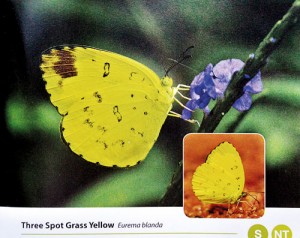Flitting among his beloved butterflies
Not only gossamer wings and vivid colours fascinate Himesh Dilruwan Jayasinghe. He is attracted to every minuscule detail in the short-span of life of these beautiful creatures.
His eyes take on a far-away look as he speaks of how he observes, makes notes and photographs butterflies just the way they are in the natural habitat, flitting from flower to flower or alighting on a flower to indulge in a moment of stillness. Just a call from a friend or varsity colleague spread across the country and Himesh will pack up a bag and take the very next bus or train to see his beloved butterflies.
These are the eye-catching photographs (14 have been contributed by Sarath Rajapakshe), along with descriptions about them that pack the well-designed ‘Common Butterflies of Sri Lanka’ launched on February 7. This book deals with 100 species of the 246 butterfly species found in the country.
With a strong yearning to get beginners to look at these magical insects closely, this reader-friendly book, due to the design expertise of Kasun Pradeepa who is also a wildlife enthusiast, provides much information at the flick of a page, easily colour-coded to identify different species by their very own colours.
‘How to use the book’ is the succinct guide and should be perused carefully to make the navigation through the pages simple and smooth, says Himesh, who has attempted to give an insight into every aspect surrounding butterflies. While the book has made a concerted effort to cover the life-cycle, the list of butterflies in the country, their distribution, the threats they face and their conservation, it also provides an interesting description about them as well as snapshots of endemic butterflies along with larval food plants.
Led to the appreciation of nature as a child by his father, Hemachandra, around their home in Malwana and also in National Parks such as Yala, Himesh first focused on birds under the gentle advice of a cousin who introduced him to systematic scientific study. Then he was only in Grade 8 at Ananda College, Colombo, but his love of nature persisted while he pursued higher studies at the University of Moratuwa from where he graduated as a civil engineer.
His membership both in the Field Ornithology Group of Sri Lanka and later the Young Zoologists’ Association cemented his interest in ecology. From birds, he moved onto fish, then reptiles and finally butterflies, after glancing through the book of Bernard d’Abrera.
Like birds, butterflies can fly, but they are different, he says, adding that unlike birds, one can get up-close to observe them. A meeting with Dr. Michael Van der Poorten further fuelled his interest and Himesh began studying the detail beyond identification of species including behaviour, distribution, life-cycle including early stages which ended with him and two friends putting out ‘A Pocket Guide on Butterflies’ in 2012.
Lamenting that unlike big animals, butterflies are not around all-year because their lifespan stretches only from about two-three weeks to about two months, he reiterates that their population depends on the special food plants they need in the early stages.
In the Dry Zone during the rains, butterfly numbers rise as the plants they feed on flourish. However, in the Wet Zone, the heavy rains in May-June wash away their eggs and larvae causing a drop, he says.
Most of the early books on butterflies are based on pinned specimens in the museum, says Himesh, adding that in their depiction the colours have changed while also not showing how they keep their wings.
He cites the examples of the butterflies which keep their wings folded and others who do the opposite of spreading their wings. In early descriptions, the identifying characteristic of the five species of Grass Yellow butterflies has been given as the shape of the black bar on the upper-side of the wings. But the bar cannot be seen because they keep their wings folded, he points out.
This is why he has photographed them as they are in the natural habitat.
Without hesitation, he zeroes in on other examples like the Three Spot Grass Yellow, the males of which often “mud-puddle” to get the salts they need. He backs up his assertion with a photograph.
Moving onto the relationships some larvae have with other animals – the Red Spot with the dimiya and the Tinsel with the kodaya – he says that at a specific time, the larvae of these butterflies release drops of nectar and the ants which drink it up do not allow predators to devour the larvae.
A ‘toxic’ attraction and mimicry are other favourites of Himesh. The Tiger and Crow types are avoided as prey by birds because at the larval stage they have consumed poisonous plants. Even the adult males, drink up the sap of poisonous plants, rather than nectar. The female butterflies are attracted to the more toxic males, who let out a stronger scent through the ‘sex gland’, as a defence mechanism to safeguard the next generation, to whom this trait will be passed, ensuring their survival.
Then there are also the imposters – Mime — who are not poisonous as prey but take on the colour patterns of those who are to keep the birds at bay from picking them as delicious morsels.
While his personal goal is to see those “rare” ones such as the Lesser Gull (usually spotted at the foothills of Sri Pada); the Clouded Silverline (found in Elephant Pass and Jaffna); the Indigo Royal (thought to be in Haldamulla but not recorded in recent times) and Malabar Flash (in Sinharaja), Himesh has a bigger vision.
Having set up the Nature Team at the Moratuwa University 11 years ago when he was an undergraduate, Himesh hopes to work towards not just the conservation of butterflies but the eco-system as a whole.
He goes back to butterflies to prove his point. The small leopard butterfly is spotted only on the Knuckles slope of Corbet’s Gap and Meemure, he says, adding that unfortunately the plant on which it lays its eggs, Rinorea decora has been declared as extinct in the National Red List of 2012. So, naturally, this butterfly may also become extinct. The Silver Forget-me-not too would face a similar fate because its food plant Flemingia macrophylla is probably extinct.
“Most of us work as species-specific experts, but the need is to get on a common platform and protect the eco-system,” is the call from Himesh.
| Dilmah’s winged friends ‘Common Butterflies of Sri Lanka’ has been sponsored by Dilmah Conservation which is sending out a clear signal — as part of a strong initiative to share knowlege leading to conservation. Having founded an urban butterfly garden at the Moratuwa MJF Centre, Dilmah Conservation Founder Merrill J. Fernando hopes that the book will not only inspire a new generation of enthusiasts to undertake further study about butterflies but also motivate people to minimize the use of harmful chemical substances in their gardens so that local butterfly populations may flourish once again. The book priced at Rs. 350 is available for purchase at the Dilmah t-lounges at the Independence Arcade and Chatham Street and soon on the shelves of the Lake House bookshops.
|



